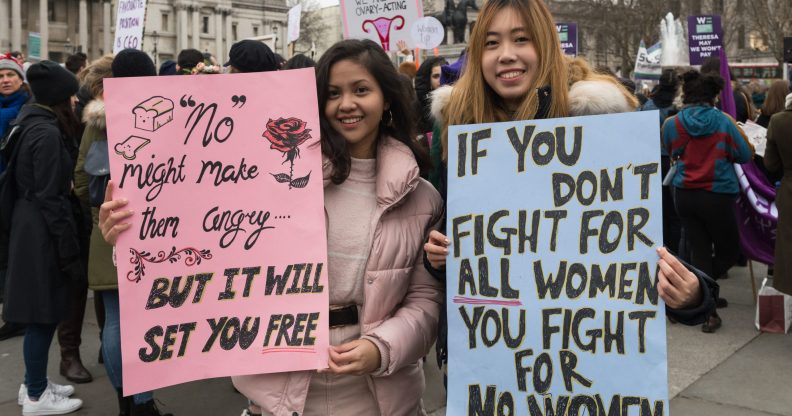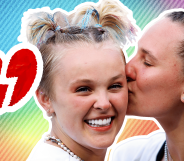Domestic abuse workers once and for all shut down the insidious myth that trans women are a threat to women’s refuges

Placards at the ‘Women’s March for Bread and Roses’ rally in Trafalgar Square, January 2019. (Wiktor Szymanowicz / Barcroft Media via Getty Images)
Placards at the 'Women's March for Bread and Roses' rally in Trafalgar Square, January 2019. (Wiktor Szymanowicz / Barcroft Media via Getty Images)
Amid increasingly toxic public debate about trans rights in Britain, women’s refuges have become a space where some anti-trans campaigners argue trans women shouldn’t be allowed.
Women’s refuges, like other single-sex spaces such as public bathrooms, prisons and changing rooms, can lawfully exclude men under the Equality Act 2010.
Some anti-trans campaigners have claimed that updating a separate law, the 2004 Gender Recognition Act, to make it easier for trans people to get their gender legally recognised, will lead to predatory men being able to access women’s refuges by “self-identifying” as trans women.
In response to these claims, and the fear they’ve generated in the public sphere, the women and equalities select committee held a public hearing in May 2019 to determine what evidence there is for them.
Janet McDermott from Women’s Aid, the national umbrella organisation for almost 300 women’s refuges, gave evidence, as did Diana James, a volunteer at Cornwall Refuge Trust and a lesbian survivor of domestic abuse, and so did Karen Ingala-Smith, the chief executive of London-based domestic-violence charity Nia.
Over the course of an hour and a half, MPs grilled the three women, trying to work out why there was so much fear about trans women in refuges.
PinkNews watched the whole thing, and eventually, it becomes clear that the “level of concern” Karen and others like her feel about trans women in women’s refuges is not driven by evidence – no examples could be given by any of the three witnesses of trans women, or cis men pretending to be trans women, accessing women’s refuges and abusing women.
The fear stems from a refusal to recognise that transgender women are women.
Karen won’t say “trans women”, instead referring to “trans identified males” who she said can be “narcissists” or “fetishists”. She argued at that session that if a women’s refuge admitted trans women fleeing domestic abuse, “it is as a matter of fact admitting women and men” and was no longer a women-only space.
Janet, who had explained Women’s Aid’s inclusive policy regarding LGBT+ survivors at length, disagreed that this was the case, restating her own and Women’s Aid’s support for and inclusion of trans women.
“We do value women’s spaces very highly,” Janet said, “but we also value flexible and responsive approaches to people’s different identities and different experiences. There’s not one model of being a woman.”
But transphobic attitudes are deeply present in the women’s sector, as a piece in Refinery 29 explained last month.
Written by Janey Starling, a domestic-violence expert who is the author of the UK’s first media guidelines for reporting on fatal domestic abuse that are now backed by all UK press regulators, and Leah Cowan, who is the former politics editor at online magazine gal-dem and works at Imkaan, a Black feminist organisation dedicated to addressing violence against Black and minorities women and girls.
“The slow drip of transphobia,” Starling and Cowan wrote, is “shutting out domestic abuse survivors who are statistically most likely to need access to lifesaving refuges and shelters”.
“Powerful voices in the UK women’s sector [seek to] leave this small minority of trans survivors with nowhere to turn,” they continued.
“It’s time for cis women to acknowledge and step outside of our own victim-survivorhood to see the bigger picture. In the fight for bodily autonomy, for freedom from gender-based violence and crushing gender norms, trans people are not only our allies, sisters and siblings, but have always been leading the way.”
‘Impossible’ for cis male abusers to gain access to women’s refuges by pretending to be trans women.
Women seeking safety in a refuge are assessed to determine what risk they pose to the other women and children living there.
Diana James, who is also a strategic adviser to the Devon and Cornwall police on hate crime, explained to PinkNews the screening process that every woman goes through before gaining entry to a refuge.
First, each woman is asked about the abuse she’s experienced, going over all the details of what happened and when.
The service provider will also check if the woman has access to public funds. Refuges need to know that the she is eligible for housing or other benefits that will cover her living costs and the cost to the refuge, otherwise they may not be able to accept her.
Does the woman have a criminal record? If she does, what is it for – a refuge might take a woman who’s been arrested for stealing food, but not if she’s been convicted of a violent crime. Does she use drugs or alcohol? Does she have children? How many? How dangerous is her abuser? Does he have access to weapons?
In the case of same-sex domestic abuse, the screening process must also ensure that a female abuser doesn’t gain access to the refuge where her former partner is staying.
After this screening process – which can take place over the phone or in person – the woman may be invited to the refuge. But she won’t be given an address; she’ll be given the description of a person who will take her to the refuge and a place to meet them, often a railway station.
All of this security is designed to ensure a dangerous abuser can’t gain access to a women’s refuge.
PinkNews asked Diana whether, as anti-trans campaigners claim, a cisgender man pretending to be a transgender woman could get through this screening process in order to gain access to vulnerable women living in refuges.
“I would say that it was impossible for a cis man to get through the screening process,” she said bluntly.
Galop runs the National LGBT+ Domestic Abuse Helpline. You can reach it on 0800 999 5428

